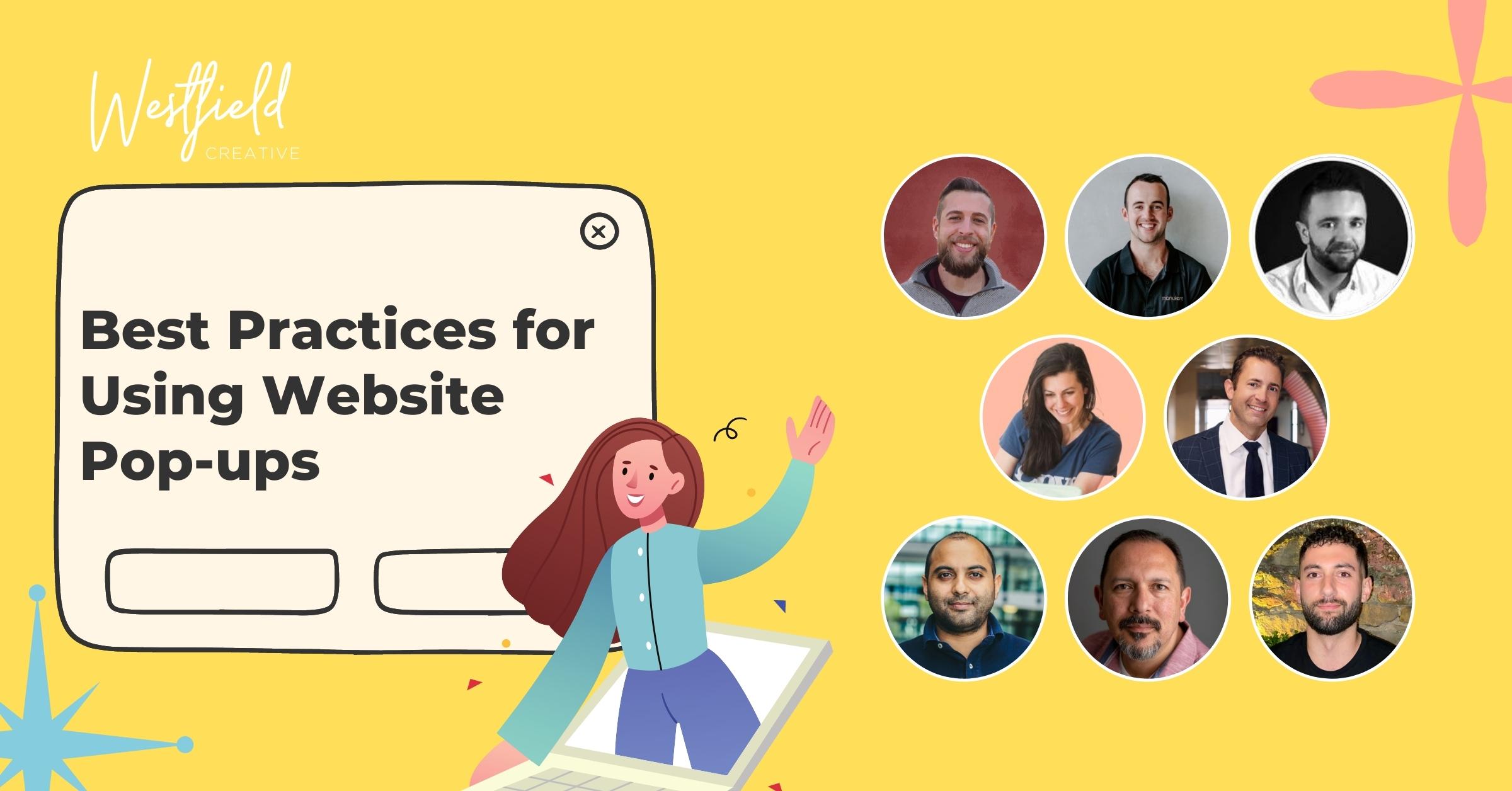
What are the best practices when implementing website pop-ups?
To help you find effective ways to implement pop-ups for your website, we asked content marketing professionals and business leaders this question for their best insights. From personalizing pop-ups to the customer lifecycle to using an enticing sign-up phrase, there are several ways to best create and feature your pop-ups to get positive response from visitors to your website.
Here are 14 best practices these leaders follow to implement website pop-ups:
- Personalize Pop-Ups to the Customer Lifecycle
- Make Sure Your Pop-Up is in the Best Interest of Your Customer
- Match Pop-Up Timing With User Behavior
- Go for a Short-Timed Pop-Up
- Be Creative With Your Pop-Up Message
- A/B-Test Ahead of Time
- Collaborate With Websites in Your Niche
- Make Your Pop-Up Simple and User-Friendly
- Let Your Email Pop-Up Appear Toward the Exit
- Use Visuals for Your Pop-Ups
- Keep Pop-Ups as Unobtrusive as Possible
- Make Your Pop-Up Easy to Close
- Avoid Leaving a Bad Experience With Your Pop-Up
- Use an Enticing Sign-Up Phrase With Your Pop-Up
Personalize Pop-Ups to the Customer Lifecycle
A huge mistake I see across all industries is serving irrelevant popups to visitors who have already done the thing you’re asking them to do. For example, serving newsletter subscription popups to visitors who are already subscribed, serving content download popups to visitors who have already downloaded that content, serving free trial popups for visitors who are already customers. Not only is it very annoying to visitors, but it’s also a huge wasted opportunity to keep visitors moving along and engaged in the next step of the customer journey.
Personalize pop-ups to move them along to the next step. For example, get anonymous traffic to subscribe to the newsletter, get newsletter subscribers to join a webinar, and anyone else left to start a free trial.
Corey Haines, SwipeWell
Make Sure Your Pop-Up is in the Best Interest of Your Customer
Make sure that your pop-up is in the best interest of your customer and not yours.
In order for it to be enticing, it needs to address the #1 pain point of your ideal customer profile and offer a free solution to that problem. By reverse engineering your ICPs pain point, you will ensure that your pop up has a high conversion rate, isn’t annoying by leaving a bad user experience, and is highly relevant to your customer (the reason why they came to your website in the first place).
Shoaib Mughal, Marketix
Match Pop-up Timing With User Behavior
It’s crucial to test what timing and intents fit best when trying to convert users through pop-ups. For example, shooting out a pop-up to sign up for your newsletter as soon as a user opens a new page is probably going to get shot down. Depending on why users are visiting a site, companies can leverage event tracking, split testing methods, and buyer personas to create pop-ups that match users’ intentions, timing, and goals. Pop-up content that populates at the wrong time, or with content that isn’t relevant to users won’t help increase conversions.
Jason Panzer, Hexclad
Go for a Short-Timed Pop-Up
Your pop-up should be less disruptive and shouldn’t last more than four seconds. Visitors are on your page because of a goal they want to achieve; it may be reading your content, signing up for your service, etc. And it can become annoying if something is blocking them from achieving that goal. As much as you can, keep your pop-up simple and straight to the point and ensure that it takes a few seconds. Interested visitors will interact with your pop-up if they want to, and the duration of time won’t force them to interact with the pop-up.
Simon Bacher, Simya Solutions
Be Creative With Your Pop-Up Message
Many websites implement pop-ups when a user is on their site. Some appear right away, while others wait 30 seconds, or for the user to reach a certain section on the website for the pop-up to appear. While not instantly bombarding a potential customer is a good practice, what the pop-up says is even more important. The bottom line is that businesses want email addresses so that they can market their products and follow up with customers who didn’t purchase. Customers know this and so they are hesitant to add their email for fear of being spammed by emails all the time. I know, because I’m one of those people who are hesitant to give out my personal email to companies.
Last year, we changed the wording on our pop-up and have seen a 3.5 to 4 % increase in submissions. Instead of “signing up” we have the user “receiving VIP Benefits”. People want that instant gratification feeling. They get it with our pop-up and receive a promo code. It’s the same functionality just worded differently.
Seth Newman, SportingSmiles
A/B-Test Ahead of Time
Be sure to utilize ab testing when implementing website pop-ups. Create two different pop-ups and then figure out which one will drive more clicks. Test out different background images, copy, layout, and the amount of time it is displayed for. Ideally, you don’t want a pop-up that never closes on its own, but it’s important to figure out if three seconds or thirty seconds yields better results. Ab testing will help you figure out which pop-up is most effective in improving your conversion rate.
Michael Bell, Manukora
Collaborate With Websites in Your Niche
Try to collaborate with websites that have a similar niche to you, it will help you significantly in finding a large potential customer base easily. People visiting the website will carry similar interests to that of the website, which will automatically indulge them in clicking the pop-ups. You are likely to gain more engagement through such kind of collaboration or paid promotion rather than showing your popups through a website that has a completely different niche than you. It is important to focus on the integration of interest to gain more and more leads at a faster rate without facing the loss of resources, which you might have to face if you go with a website with a completely different niche. It is because the people visiting the page are likely not interested in your popup. After all, currently, re is something else on their mind.
Jeremy James, Blue Water Climate Control
Make Your Pop-Up Simple and User-Friendly
Pop-ups are annoying, however, pop-ups on the website can encourage users one step closer – like the email sign-ups through coupons. This works because most people, when they see a coupon, are attracted to it and they want to try the product and experiment with how it works. This works for many companies who use a simple and user-friendly method. The pop-up gains the users through a simple email address space and at one click it drives to the conversion. Therefore, you acquire the visitor’s email address and make an influence with the exciting products of your brand.
Brigid Davey, Nimble
Let Your Email Pop-Up Appear Toward the Exit
The best type of popup for your website is the exit intent popup. It is not a good option to have a popup asking for your email address while you are still searching the site. It is annoying and can lead to increased bounce rates. A much better option is to have the email popup appear when the intent is already begun to exit the website. This way you can give them an offer and try to get permission to email them before they leave the site.
Doug Darroch, Renaissance Digital Marketing
Use Visuals for Your Pop-Ups
All information on the internet benefits greatly from the inclusion of images and other visual components. Lots of studies have found that they improve the overall appeal of websites, especially when they feature actual people. As an added bonus, visuals can help direct the focus of the user exactly where you want it to go. This includes window pop-ups. Yours will have a greater impact if you incorporate visuals. It adds a level of excitement, novelty, and interest to your marketing efforts, increasing their effectiveness. However, it is not necessary to always use full-size pictures. Some designs just need a more interesting background pattern or some brighter accent colors to really stand out.
Billy Parker, Gift Delivery
Keep Pop-Ups as Unobtrusive as Possible
I have A/B tested many different pop-ups. The best practice when implementing website pop-ups is to make it as unobtrusive as possible. To attain this, you need to set the trigger correctly, and I have found setting the popup trigger after they have been on a page for over 30 seconds is the best. If your trigger is too sensitive, the popup will just annoy the user, and they will bounce immediately.
Jordan Woolf, We Buy Houses in Bama
Make Your Pop-Up Easy to Close
When creating a pop-up, you want to make sure it provides value to the user and doesn’t disrupt their browsing experience. A best practice is to make sure you have an “X” button in your pop-up to allow users to close it if they want to. Creating an easy way out of your pop-up will make sure users aren’t annoyed by it, and they’ll be more likely to stay on your website.
Peter Beeda, fhalend
Avoid Leaving a Bad Experience With Your Pop-Up
Popups disrupt the user’s journey and can leave a bad experience. However, if the popup is genuinely valuable and offers the user something for free (that they’d otherwise pay for) you can expect incredible conversion rates. This is exactly what I did with Ticker Nerd, my investing newsletter that has since been acquired. All pages had a popup that promised to show visitors the investing process. And we did exactly this. We broke down exactly how we surfaced interesting stocks. Our emails were often reopened up to 10 times in some cases.
Luciano Viterale, Luciano Viterale Consulting
Use an Enticing Sign-Up Phrase With Your Pop-Up
A great popup should have the following:
– specific timing (does it show after 2 seconds, 5 seconds, 10 seconds, or on exit)
– a great image or offer
– a first name and email field
– something other than “subscribe to my newsletter”
There is nothing more unappealing than “subscribe to my newsletter.” Pop-Ups should entice others to sign up. For example, “Grab my free Mailchimp Cheat Sheet!” sounds a lot more exciting than “subscribe to my newsletter.”
Emily Ryan, Westfield Creative



